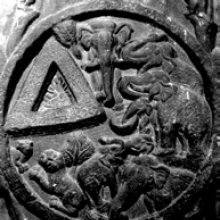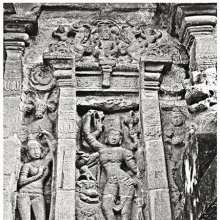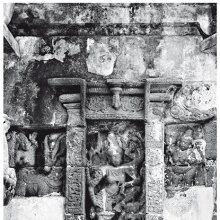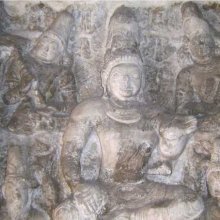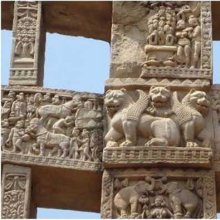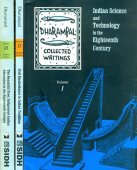Lion: 4 definitions
Introduction:
Lion means something in Buddhism, Pali, Hinduism, Sanskrit, the history of ancient India. If you want to know the exact meaning, history, etymology or English translation of this term then check out the descriptions on this page. Add your comment or reference to a book if you want to contribute to this summary article.
Images (photo gallery)
(+78 more images available)
In Hinduism
Natyashastra (theatrics and dramaturgy)
Source: Shodhganga: Elements of Art and Architecture in the Trtiyakhanda of the Visnudharmottarapurana (natya)1) The Gait of the Lion is denoted by the Sanskrit term Siṃhagati, and represents one of the various Gatis (“way of walking”) (in Indian Dramas), according to the Abhinayadarpaṇa.—Accordingly, gaits (gatis) are explained along with some particular hand gestures. It shows that footsteps are to be followed by some hand postures. In the gait of siṃha i.e., lion, the actor or dancer should stand on toes first and then jump forward speedily. The śikharahasta is adopted with both hands in this gait. Frog step is suggested to do exactly as the gait of siṃha-gati in the Abhinayadarpaṇa.
2) Lions are associated with Makarahasta: one of the thirteen Combined-hand Gestures (in Indian Dramas) (known as saṃyuktahastas).—According to the Śabdakalpadruma, makara means sea-animals like Kumbhīra, Kūrma, Kāca, Godhā, Śaṅkava, Śvaṇitaka, Śiśumāra etc. According to the Viṣṇudharmottarapurāṇa, in Makara posture both of the hands in patāka posture are placed one over the other and both should be facing downward. This posture is used in the acting of lion, tiger and deer.
3) The Lion (in Sanskrit: Siṃha) is also related to Narasiṃha-avatāra, which refers to one of the Daśāvatāra (“ten incarnations”) (of Lord Viṣṇu) to which are assign various hand gestures (in Indian Dramas), according to the Viṣṇudharmottarapurāṇa.—The term Narasiṃha is the union of two Sanskrit words viz., nara and siṃha. Nara means man and Siṃha means lion. So, this incarnation of lord Viṣṇu shows his form of half man and half lion. It is the most furious incarnation of lord Viṣṇu.

Natyashastra (नाट्यशास्त्र, nāṭyaśāstra) refers to both the ancient Indian tradition (shastra) of performing arts, (natya—theatrics, drama, dance, music), as well as the name of a Sanskrit work dealing with these subjects. It also teaches the rules for composing Dramatic plays (nataka), construction and performance of Theater, and Poetic works (kavya).
Vastushastra (architecture)
Source: Shodhganga: Elements of Art and Architecture in the Trtiyakhanda of the Visnudharmottarapurana (vastu)Lion-shaped Temples (in ancient Indian architecture) are denoted by the Sanskrit term Siṃha, as described in literature such as the Viṣṇudharmottarapurāṇa, an ancient Sanskrit text which (being encyclopedic in nature) deals with a variety of cultural topics such as arts, architecture, music, grammar and astronomy.—It is quite difficult to say about a definite number of varieties of Hindu temples but in the Viṣṇudharmottarapurāṇa hundred varieties of temples have been enumerated. For example, Lion-shaped. These temples are classified according to the particular shape, amount of storeys and other common elements, such as the number of pavilions, doors and roofs. [...] The Viṣṇudharmottarapurāṇa relates that the temple named Siṃha should be constructed in the shape of a Lion.

Vastushastra (वास्तुशास्त्र, vāstuśāstra) refers to the ancient Indian science (shastra) of architecture (vastu), dealing with topics such architecture, sculpture, town-building, fort building and various other constructions. Vastu also deals with the philosophy of the architectural relation with the cosmic universe.
In Buddhism
Tibetan Buddhism (Vajrayana or tantric Buddhism)
Source: academia.edu: The Structure and Meanings of the Heruka MaṇḍalaThe Lion is associated with the Yoginī (female deity) named Siṃghī, being situated in the Medinīcakra, according to the 10th century Ḍākārṇava-tantra: one of the last Tibetan Tantric scriptures belonging to the Buddhist Saṃvara tradition consisting of 51 chapters.—Accordingly, the medinīcakra refers to one of the three divisions of the dharma-puṭa (‘dharma layer’), situated in the Herukamaṇḍala. The 36 pairs of Ḍākinīs [viz., Siṃghī] and Vīras are yellow in color; the shapes of their faces are in accordance with their names [e.g., Lion]; they have four arms; they hold a skull bowl, a skull staff, a small drum, and a knife.

Tibetan Buddhism includes schools such as Nyingma, Kadampa, Kagyu and Gelug. Their primary canon of literature is divided in two broad categories: The Kangyur, which consists of Buddha’s words, and the Tengyur, which includes commentaries from various sources. Esotericism and tantra techniques (vajrayāna) are collected indepently.
India history and geography
Source: Singhi Jain Series: Ratnaprabha-suri’s Kuvalayamala-katha (history)Lions were commonly depicted on the Saṃsāracakra paintings (representing scenes of animal life), in ancient India, as mentioned in the Kathās (narrative poems) such as Uddyotanasūri in his 8th-century Kuvalayamālā (a Prakrit Campū, similar to Kāvya poetry).—Page 185.21 f.: Here follows a description of a printed scroll illustrating the Jaina conception of saṃsāracakra. [...] The saṃsāra-cakra illustrated the three worlds of hell, human world and the world of gods. [For example:] Scenes of bird and animal life, e.g., fight between lion and elephant (as depicted in the Kailāsa temple at Ellora).

The history of India traces the identification of countries, villages, towns and other regions of India, as well as mythology, zoology, royal dynasties, rulers, tribes, local festivities and traditions and regional languages. Ancient India enjoyed religious freedom and encourages the path of Dharma, a concept common to Buddhism, Hinduism, and Jainism.
See also (Relevant definitions)
Starts with: Lion banner, Lion bush, Lion throne.
Ends with: Common dandelion, Dandelion, Kelion, Lotus-medallion, Mongolian dandelion, Mosolion, Neer-pongelion, Nir-pongelion, Pavilion, Pavillion, Pongelion, Vermilion.
Full-text (+2056): Simha, Simhasana, Saimha, Simhanada, Nrisimha, Parindra, Mrigendra, Simhadhvani, Keshari, Shvetapinga, Mrigaraj, Sharabha, Mrigarati, Bhari, Vikramin, Shailata, Shardula, Siha, Bhimavikranta, Manastala.
Relevant text
Search found 284 books and stories containing Lion; (plurals include: Lions). You can also click to the full overview containing English textual excerpts. Below are direct links for the most relevant articles:
The Jataka tales [English], Volume 1-6 (by Robert Chalmers)
Jataka 172: Daddara-jātaka < [Book II - Dukanipāta]
Jataka 152: Sigāla-jātaka < [Book II - Dukanipāta]
Jataka 241: Sabbadāṭha-jātaka < [Book II - Dukanipāta]
Animal Kingdom (Tiryak) in Epics (by Saranya P.S)
Chapter 4.14 - The Lion in the Epics
Chapter 6.14 - Shakuntala-upakhyana
Parables of Rama (by Swami Rama Tirtha)
Story 143 - No Gain without Pain < [Chapter XXIII - Sufferings]
Story 198 - Lions and Elephants < [Chapter XXXV - Self-confidence]
Story 212 - The saint and the lion < [Chapter XXXIX - God Consciousness]
Saying 7 - The Lion And The Human Being
Saying 60 - A Parable Of A Samaritan And A Lamb
Tibetan tales (derived from Indian sources) (by W. R. S. Ralston)
Jain Remains of Ancient Bengal (by Shubha Majumder)
Pañca-tīrthika type of Mahāvīra sculptures < [Chapter 6 - Iconographic Study of Jaina Sculptural Remains]
Single depiction of Mahāvīra sculptures < [Chapter 6 - Iconographic Study of Jaina Sculptural Remains]
Planetary Deities type of Mahāvīra Sculpture < [Chapter 6 - Iconographic Study of Jaina Sculptural Remains]
Related products
